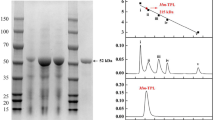Abstract
The cells ofEscherichia intermedia A-21, known as a producer of tyrosine phenol lyase, are shown to produce D-serine dehydratase, L-serine dehydratase, and alanine racemase. Since the specific activities of the latter by far exceed that of tyrosine phenol lyase, minor concentrations of these independent enzymes in purified preparations of tyrosine phenol lyase may cause the observed levels of side activities with respect to serine and alanine. In the light of the results obtained, the assumption of the polysubstrate nature of tyrosine phenol lyase seems insufficiently substantiated.
Similar content being viewed by others
Literature Cited
Alföldi, L., Rasko, I. 1970. L-serine deaminating enzymes inEscherichia coli crude extracts. FEBS Letters6:73–76.
Brot, N., Smit, Z., Weissbach, K. 1965. Conversion of L-tyrosine to phenol byClostridium tetanomorphum. Archives of Biochemistry and Biophysics112:1–6.
Carman, G., Levin, R. 1977. Characteristics of tyrosine, phenol-L-lyase fromAeromonas phenologenes. Journal of Food Biochemistry1:285–299.
Carman, G., Levin, R. 1977. Partial purification and some properties of tyrosine phenol-lyase fromAeromonas phenologenes ATCC 29063. Applied and Environmental Microbiology33:142–198.
Dupourque, D., Newton, A., Snell, E. 1966. Purification and properties of D-serine dehydratase fromEscherichia coli. Journal of Biological Chemistry245:1233–1238.
Enei, H., Matsui, H., Yamashita, K., Okumura, S., Yamada, H. 1972. Microbiological synthesis of L-tyrosine and 3,4-dihydroxyphenyl-S-alanine. I. Distribution of tyrosine phenol lyase in microorganisms. Agricultural and Biological Chemistry36:1861–1868.
Faleev, N., Martinkova, N., Sadovnikova, M., Saporovskaya, M., Belikov, V. 1982. The L- and D-threonine dehydratases accompanying L-tyrosine phenol-lyase: selective decomposition of D-threonine in racemic mixture. Enzyme and Microbial Technology4:164–168.
Faleev, N., Sadovnikova, M., Martinkova, N., Belikov, V. 1981. Catalytic properties of extracts from tyrosine phenol lyase producing cells ofEscherichia intermedia: multienzyme complex instead of the single multisubstrate enzyme. Enzyme and Microbial Technology3:219–224.
Gannon, F., Bridgeland, E., Jones, K. 1977. L-serine dehydratase fromArthrobacter globiformic. Biochemical Journal161:345–355.
Kumagai, H., Kashima, N., Torii, H., Yamada, H., Enei, H., Okumura, S. 1971. Purification, crystallization and properties of tyrosine phenol lyase fromErwinia herbicola. Agricultural and Biological Chemistry36:472–482.
Kumagai, H., Kashima, N., Yamada, H. 1970. Racemization of D- or L-alanine by crystalline tyrosine phenol-lyase. Biochemical and Biophysical Research Communications39:796–801.
Kumagai, H., Matsui, H., Yamada, H. 1970. Formation of tyrosine phenol lyase by bacteria. Agricultural and Biological Chemistry34:1259–1261.
Kumagai, H., Yamada, H., Matsui, H., Ohkishi, H., Ogata, K. 1970. Tyrosine phenol lyase: purification, crystallization and properties. Journal of Biological Chemistry245:1767–1772.
Labow, R., Robinson, W. 1966. Crystalline D-serine dehydratase. Journal of Biological Chemistry241:1239–1243.
Lowry, O., Rosebrough, N., Farr, A., Randall, R. 1958. Protein measurement with the Folin phenol reagent. Journal of Biological Chemistry193:265–275.
Pardee, A., Prestige, L. 1955. Induced formation of serine and threonine deaminases byEscherichia coli. Journal of Bacteriology70:677–684.
Saporovskaya, M., Paskonova, E., Nikitina, S., Vitt, S., Belikov, V. 1974. GLC enantiomeric analysis of amino acids [in Russian]. Izvestija Academii Nauk SSSR (Serija Khimicheskaya) 676–682.
Sysuev, V., Tysyachnaya, I., Yakovleva, V., Kupletskaya, M., Berezin, I. 1980. Isolation, purification and some properties of tyrosine phenol lyase fromCitrobacter freundii cells [in Russian with English summary]. Biokhimiya45:889–895.
Umbarger, H. 1956. Evidence for a negative-feed-back mechanism in the biosynthesis of isoleucine. Science123:848.
Yonaba, K., Vorifuji, T., Yamamoto, T., Soda, K. 1975. Alanine racemase ofBacillus subtilis var. A aterrimus. Journal of Fermentation Technology53:579–587.
Author information
Authors and Affiliations
Rights and permissions
About this article
Cite this article
Faleev, N.G., Vikha, Y.K., Martinkova, N.S. et al. Enzymes accompanying tyrosine phenol lyase and the problem of its substrate specificity. Current Microbiology 9, 235–239 (1983). https://doi.org/10.1007/BF01567193
Issue Date:
DOI: https://doi.org/10.1007/BF01567193




